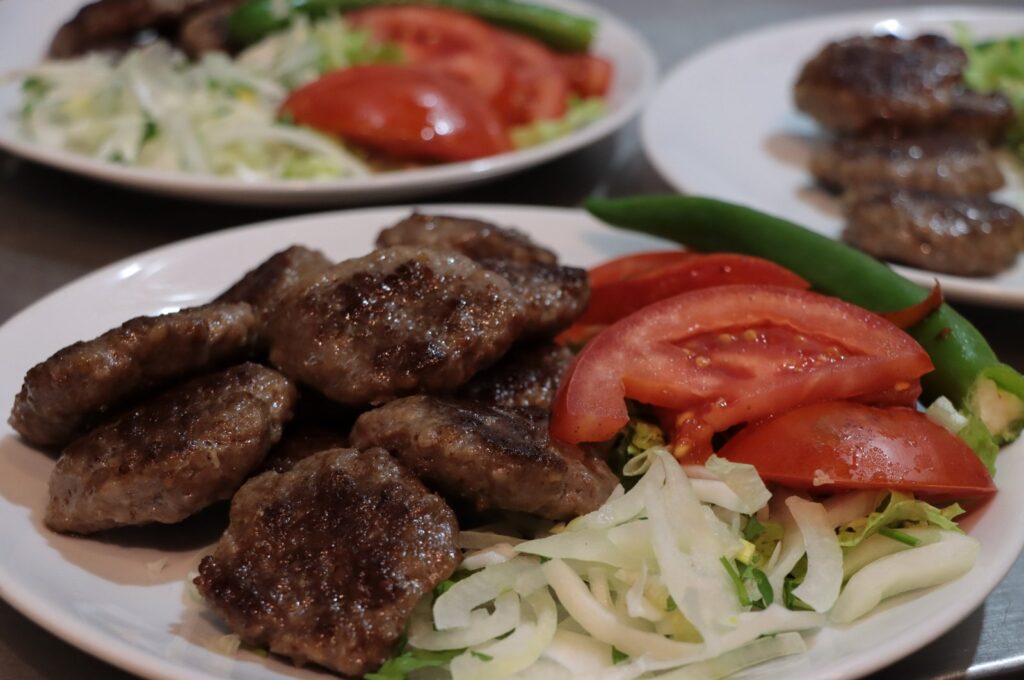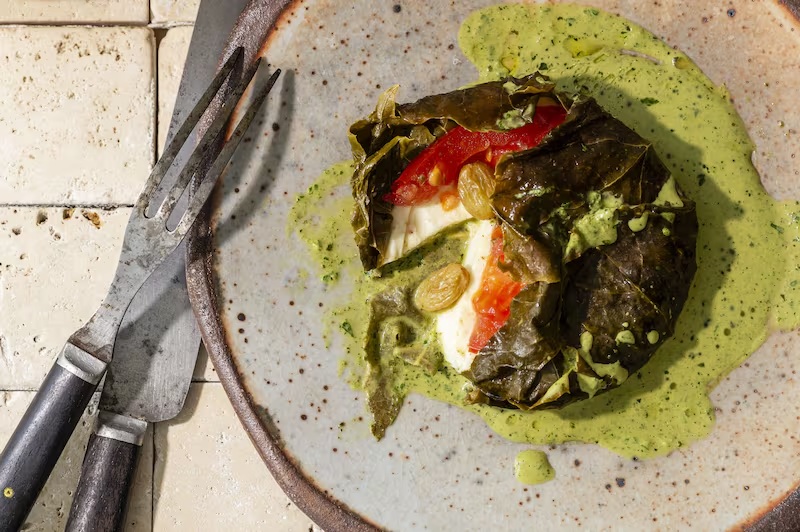
Anna Muckerman
If you want to know just how attached the people of the coastal town of Menton are to their beloved lemon, look no further than the legend that credits its arrival on the French Riviera to Eve.
Expelled from the garden of Eden, the story goes, Eve plucked a lemon to take with her on the journey. Adam, fearing eternal condemnation, begged her to throw it away, which she obliged to do only in a spot of her choosing.
And thus, she found Menton, situated on the gleaming Bay of Garavan where the Alps rescind from the water just enough to create slopes with an east-west alignment – the perfect conditions for cultivating lemons.
While the legend itself is impossible to authenticate, the symbolism of the paradisiacal lemon is embedded in the folklore of this seaside town of about 30,000 inhabitants, where the bus line is called “Zeste” and a lemon motif seems the logical choice for many local businesses.
The town swells to nearly double its size during the Fête du Citron, an annual festival held in February celebrating the history and culture of citrus growing in the region, most notably of the Menton lemon, an officially recognised species that differs from Corsican, Spanish or Italian varieties in terms of its mild flavour and large, round shape with bumpy skin.
The allure of the festival lies in its floats and sculptures, each with more than three tonnes of lemons and oranges rubber-banded to a wire framework shaped to match the year’s theme. The Fête du Citron stands apart from other Carnival events in France in that municipal workers who spend most of the year maintaining city buildings are also the ones who prepare the floats and sculptures.

Producers are again seeing the potential of the Menton lemon (Credit: Anna Muckerman)
Titled Operas and Dances, the 2022 edition marked a triumphant return for the festival after it was cancelled midway through in 2020 due to the coronavirus pandemic. The Sunday parade was a jubilee of blaring marching bands, vibrant performers and six floats covered in lemons and oranges, some as tall as 10m, sculpted to represent the Samba, Can-can, Haka, Matachines, Salsa and Kathakali dance styles.
From the floats, performers in costume worked alongside smiling city employees in neon-green safety vests to shower a seemingly infinite amount of confetti on the 15,000 spectators, whose outstretched arms made it clear they couldn’t get enough.
As the party raged on in the valley, the terraced hillsides overlooking the town harboured a harsher reality: Menton was once the leading lemon-growing region in all of Europe, but today, only about 15 producers remain. All the fruit for the Fête du Citron’s sculptures and floats must be imported from Spain.
“The annual production of Menton lemons is between 100 and 120 tonnes. In this period, we need between 150 and 180 tonnes of lemons and oranges. So, the production of Menton lemons wouldn’t be enough to create the whole of the Fête du Citron,” said Christophe Ghiena, the city’s director of technical services, who added that the remaining citrus is sold at discounted prices after the festival.https://emp.bbc.com/emp/SMPj/2.44.14/iframe.html The French town celebrating a lemon
Aside from its Biblical legend, the documented story of the Menton lemon’s rise and fall began with its arrival from Spain in the 15th Century. The fruit quickly adapted to Menton’s temperate microclimate created by the unique combination of a protective mountain range and proximity to the ocean. By the end of the 18th Century, the region was estimated to produce one million lemons annually, said David Rousseau, director of Menton’s heritage department.
“In the 17th, 18th and 19th Centuries, the lemon was really the fortune of the city of Menton. Lemons were exported all the way to the United States, to Russia. It was a production of global scale,” he said.
It was a production of global scale
The Menton lemon’s decline began at the end of the French Revolution, when laws that had protected it against competition from other lemon-producing regions were lifted. The second blow came in the 19th Century, when the arrival of British winter tourists prompted the construction of hotels and villas on land used for citrus terraces. Finally, in the 1950s, an unusual cold snap spelled the Menton lemon’s demise.
“There was a big freeze in Menton and in France, which killed the remaining lemon trees,” Rousseau said. “It was in the 1980s that the lemon began to come back thanks to several producers who saw the lemon had potential and relaunched its production.”

Laurent Gannac (pictured) and his son own 750 Menton lemon trees on 2.5 hectares of land (Credit: Anna Muckerman)
One such grower is Laurent Gannac. Originally from the southwest of France, Gannac arrived in Menton in 1988 to work as a landscaper. He said that every time he brought lemon trees to clients in the area, he’d get the same question: Is this a Menton lemon?
“I had scientific, agricultural training and I’d never even heard of a Menton lemon,” he said. “So, I’d say to them ‘Well, I brought it from Menton so I guess it’s a Menton lemon if you want.’”
He soon became curious about the species and, in 1991, he planted his first Menton lemon tree. At the time, the few remaining producers questioned why a young person would be interested in a seemingly bygone product, Gannac said.
Today, Gannac and his son own 750 trees on 2.5 hectares of land with the goal of reaching 1,000 trees in the next three years. Although his operation pales in comparison to the output of producers in Spain or Italy, Gannac is proud to call himself the first person in recent years to live entirely off the Menton lemon. Yet, he is one of very few.
“To plant 400 trees here means to start with a site that’s completely abandoned, clear it, level the terraces, create irrigation reservoirs and fence it to protect from wild boars,” he said. “It’s a lot of work, especially when you consider it takes eight years to recoup the investment.”

The French town of Menton swells to nearly double its size during the Fête du Citron (Credit: Anna Muckerman)
Now, Gannac says he believes the tide is changing, thanks in large part to an effort by local officials, growers and other stakeholders to achieve the European Union’s Protected Geographical Indication for the Menton lemon, which it received in 2015.
Although he had been cultivating the Menton lemon for nearly two decades at the time, it was during this process that Gannac was confronted with the uniqueness of the species during a visit to France’s National Institute for Agricultural Research.
“I always thought the Mentonnais were a little biased about their lemon,” he said. “When I had the chance to go from tree to tree and taste each lemon, I realised that the real Menton lemon is actually different from others in its scent, sweetness and peel that is so mild it can be eaten.”
The Menton lemon has also been praised for its thick skin and high essential oil content which makes it a favourite of well-known chefs like Mauro Colagreco at the helm of Mirazur, the Menton restaurant ranked number one in the World’s 50 Best in 2019.
“The Menton lemon is a very rare product. It has a different flavour and texture from the lemons you find elsewhere and can even be eaten directly from the tree (as a fruit). In our five gardens, we want to keep this exceptional variety. Each year we plant new trees to perpetuate the culture,” Colagreco said.

Menton was once the top lemon growing region in all of Europe (Credit: Anna Muckerman)
When in season, the chef uses the fruit in dishes like a Menton lemon tart or a tourbillon (swirl) of fish larvae with Menton lemon and chives. He also produces a lemon confit to “remember the flavour all year long”.
Colagreco is not the only chef who has become an ambassador of the species. Luisa Delpiano-Inversi is the founder of Pasta Piemonte, a Menton-based pasta producer that opened in 2013. Shortly thereafter, Delpiano-Inversi found success with her Menton lemon ravioli, an unexpected combination that she now ships across France for those who live far from the Riviera to experience.
“This lemon resembles no other,” she wrote in her 2017 book on the topic. “Its juice is intensely fragrant with a semi-acidic flavour and no bitterness.”
Gannac said he remembers a time when the Menton lemon was little more than a pretext used to draw in tourists during the Fête du Citron, which began in 1934. As French consumers become increasingly interested in local products, Gannac now credits the Fête with giving him an opportunity to meet his customers and speak about the uniqueness of his fruit.
Rousseau agrees that the recent editions of the Fête du Citron have helped bring more awareness to the Menton lemon. Many of this year’s guided tours of lemon terraces were sold out.

The Fête du Citron celebrates the history and culture of citrus growing in the region (Credit: Anna Muckerman)
“The visitors are a lot more interested in the story of the Menton lemon than before. Before they came mostly to see the sculptures and attend the parade,” he said. “Today, they really wish to discover the city and not just come to see the floats.”
Perhaps the most promising result of the local effort to revitalise the species can be found in the enthusiasm of the next generation of lemon growers, among them Laetita Sepicacchi, a Menton native who began cultivating her family’s property in 2015 in collaboration with the city’s initiative to plant more trees.
The visitors are a lot more interested in the story of the Menton lemon than before
At the time, Sepicacchi was working in Paris and often travelled home to Menton to rest and recharge. It was during one of these visits that she realised the terraces of the former vineyard were the perfect place to continue the tradition of lemon cultivation. While she waits for her 35 young trees to reach maturity, Sepicacchi harvests about 100kg of fruit per year from three older trees. She sells her lemons to individuals and French and European grocers, although some of her clients have also been reputable perfume producers interested in the essential oils of her lemons.
“This project allows me to rediscover and transmit a cultural heritage,” she said. “It’s as if the roots of the trees are grounded in a heritage and an identity at a time when the world is steeped in virtual culture, which can sometimes be materialistic and individualistic.”
When Sepicacchi reflects on her ultimate goal to cultivate the Menton lemon, she imagines a day when lemon trees can once again define the local landscape and support the town’s economy, maybe even resembling the French poet Stéphen Liégeard’s 1887 description: “little valleys that leave to the breeze the care to shake passers-by, the heady smell of lemon trees.”
Courtesy: BBC
The post The return of France’s lost lemon appeared first on The Frontier Post.








